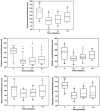Superficial Keratectomy and Conjunctival Advancement Hood Flap (SKCAHF) for the Management of Bullous Keratopathy: Validation in Dogs With Spontaneous Disease
- PMID: 27538190
- PMCID: PMC5602554
- DOI: 10.1097/ICO.0000000000000966
Superficial Keratectomy and Conjunctival Advancement Hood Flap (SKCAHF) for the Management of Bullous Keratopathy: Validation in Dogs With Spontaneous Disease
Abstract
Purpose: To evaluate the efficacy of superficial keratectomy and conjunctival advancement hood flap (SKCAHF) for the treatment of bullous keratopathy in canine patients.
Methods: Nine dogs (12 eyes) diagnosed with progressive corneal edema underwent superficial keratectomy followed by placement of conjunctival advancement hood flaps. The canine patients were examined pre- and postoperatively using in vivo confocal microscopy, ultrasonic pachymetry (USP), and Fourier-domain optical coherence tomography (FD-OCT). All owners responded to a survey regarding treatment outcomes.
Results: Mean central corneal thickness (CCT) as measured by FD-OCT was 1163 ± 290 μm preoperatively and significantly decreased postoperatively to 795 ± 197 μm (P = 0.001), 869 ± 190 μm (P = 0.005), and 969 ± 162 μm (P = 0.033) at median postoperative evaluations occurring at 2.2, 6.8, and 12.3 months, respectively. Owners reported significant improvement (P < 0.05) in vision and corneal cloudiness at 6.8 and 12.3 months postoperatively. The percentage of cornea covered by the conjunctival flap was correlated (P = 0.0159) with a reduction in CCT by USP at 12.3 months postoperatively. All canine patients were comfortable pre- and postoperatively.
Conclusions: SKCAHF results in a reduction of corneal thickness in canine patients with bullous keratopathy. The increase in corneal thickness over time, after performing SKCAHF, is likely because of progressive endothelial decompensation. This surgery is a potentially effective intervention for progressive corneal edema in dogs that may have value in treatment of human patients with bullous keratopathy.
Conflict of interest statement
The authors have no conflicts of interest to disclose.
Figures







References
-
- Anshu A, Price MO, Tan DT, et al. Endothelial keratoplasty: a revolution in evolution. Surv Ophthalmol. 2012;57:236–252. - PubMed
-
- Koenig SB, Covert DJ. Early results of small-incision Descemet's stripping and automated endothelial keratoplasty. Ophthalmology. 2007;114:221–226. - PubMed
-
- Ing JJ, Ing HH, Nelson LR, et al. Ten-year postoperative results of penetrating keratoplasty. Ophthalmology. 1998;105:1855–1865. - PubMed
-
- Knezović I, Dekaris I, Gabrić N, et al. Therapeutic efficacy of 5% NaCl hypertonic solution in patients with bullous keratopathy. Coll Antropol. 2006;30:405–408. - PubMed
-
- Gasset AR, Kaufman HE. Bandage lenses in the treatment of bullous keratopathy. Am J Ophthalmol. 1971;72:376–380. - PubMed
Publication types
MeSH terms
Grants and funding
LinkOut - more resources
Full Text Sources
Other Literature Sources

